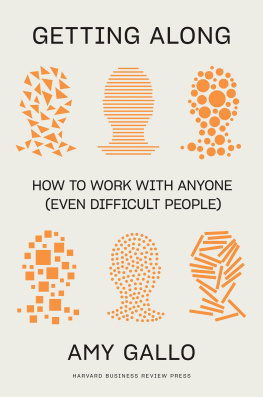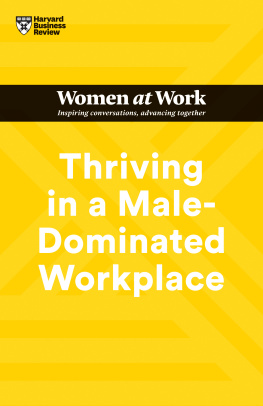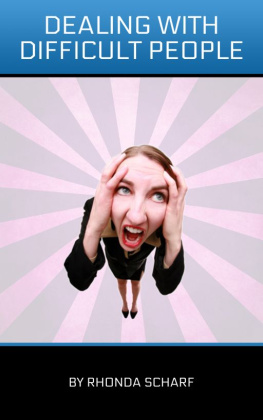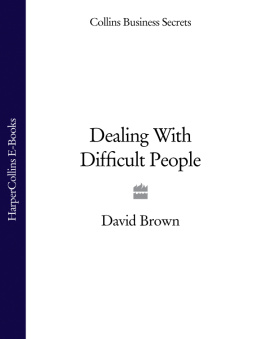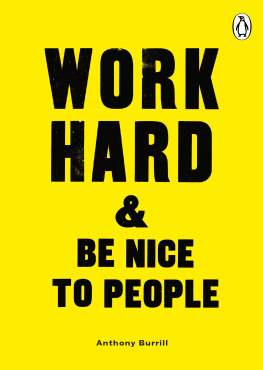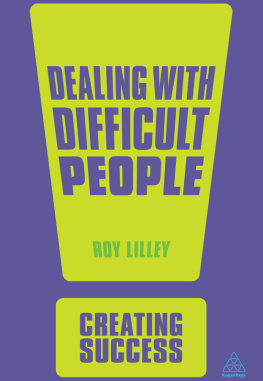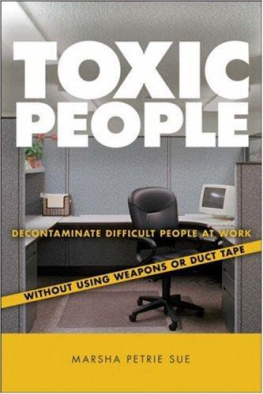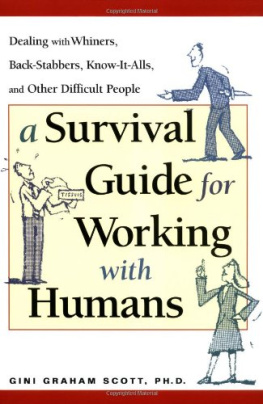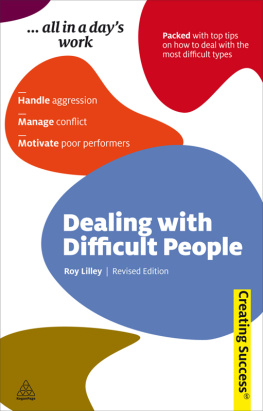Contents
Guide
ACKNOWLEDGMENTS
I have a confession. I love reading the acknowledgments in a book. Sometimes Ill even turn to them first when I pick up a new book. This minor obsession of mine is in part because I know that the notion of an author sitting in a room alone, writing a book, is rarely a reality. Yes, there are lots of hours staring at a screen by yourself, but there are also endless conversations and check-ins and drafts weighed in on and back-and-forth texts, all of which make the book what it is. There are so many people who influence the end productoften too many to name and several of whom the author probably forgot were even involved.
So, welcome to my favorite part of the book!
First off, thank you to everyone who wrote to me, answered my calls, or filled out surveys sharing their often-painful experiences with their difficult colleagues. These stories, and the vulnerability with which they were shared, pushed my thinking in ways I couldnt conceive of when I first started working on this book.
Even editors need editors! And several of my fellow editors were integral to this process. Kate Adams breathed life into these pages with her sharp editing eye and incredible way with words. Writing a book is a series of tough calls about what to include, what to cut, how to frame something, and Kate was there every step of the way. Nicole Torres supported me in the research on archetypes and provided some well-timed cheerleading early in the process when I had the confidence wobbles. Amanda Kersey asked smart, insightful questions (her superpower) on a very early outline of the archetypes. Holly Forsyth wrestled the mess of endnotes into shape.
Jeff Kehoe, from the first moment I described the book concept to him, believed in it and in me. His calm demeanor and assured guidance saw me through the various valleys of despair that many writers experience in the book-writing process.
Thank you to my agent, Giles Anderson, for having my back throughout the (long) book process. When I called to tell him I needed an extension on the manuscript, he told me that I wasnt aloneseveral of his authors had made similar requests that week! He was patient and kind, and his counsel was just what I needed at critical moments. I feel fortunate to have him on my side.
A huge thank you to Erica Truxler, Alison Beard, Holly Forsyth, Maureen Hoch, Sarah Moughty, and Dagny Dukach for stepping up at crucial moments to give me the space I needed to work on this book. Amy Bernstein gave me some brief and incisive compliments ( her superpower) when I needed them most. And the entire web team at HBR was understanding and flexible with my schedule as I worked on this book over the last two years. You are the best colleagues I could ask for, and none of the archetypes are based on you, I promise.
I was lucky to already know the Harvard Business Review Press team before I started working on this particular book, and I continue to be impressed with their professionalism, enthusiasm, and dedication: Adi, Alex, Alicyn, Allison, Anne, Brian, Courtney, Dave, Emma, Erika, Felicia, Jen, Jon, Jordan, Julie, Kevin, Lindsey, Melinda, Rick, Sal, Scott, Stephani, Susan, and Victoria.
Im grateful to all my friends who answered panicked calls, reviewed chapters, gave me invaluable advice, and cheered me along the way: Amy Genser, Amy Jen Su, Ellie Feinglass, Gretchen Anderson, Katherine Bell (who talked me off a metaphorical ledge multiple times), Lisa Freitag (who wrote the tag lines for each of the archetypes), Mark Moskovitz, Megan Poe, Muriel Wilkins, and Ruchika Tulshyan (who was a few months ahead of me in the book process and was always generous with her hard-earned wisdom).
Kelley Boyd (aka Pants) is not only a lifelong friend and fantastic travel companion but an incredible coworker, and the sole member (besides me!) of the Amy E. Gallo team. Thank you for everything, big and small, that you do for me, our business, and this book.
Last but not least, I am indebted to the people who I consider my family, either because we share genes or because we are close enough that it feels like we do. You all have shown me over and over that we can choose what we want our relationships to be. My mom, Betty Gallo, curated this amazing family for me and my brother, Chris. She showed us that caring about your work is crucial, but caring about people matters even more.
Damion, you never once doubted I could do this, even when I did. Harper, you teach me every day what it means to be a thoughtful, kind human being.
I miss you, Dante.
ABOUT THE AUTHOR
AMY GALLO is a workplace expert who frequently writes and speaks about gender, interpersonal dynamics, difficult conversations, feedback, and effective communication. She works with individuals, teams, and organizations in the United States and abroad to help them collaborate, improve how they communicate, and transform their organizational culture to one that supports dissent and debate.
Gallo is the author of the HBR Guide to Dealing with Conflict, a how-to book about handling conflict professionally and productively. She has written hundreds of articles for Harvard Business Review , where she is a contributing editor. Her writing has been collected in numerous books on a range of topics, from feedback to emotional intelligence to managing others.
For the past three years, Gallo has cohosted HBRs popular Women at Work podcast, which examines the struggles and successes of women in the workplace.
Gallo is a sought-after speaker who has delivered keynotes and workshops at hundreds of companies and conferences, including SXSW, the Conferences for Women, the World Economic Forum, the Bill & Melinda Gates Foundation, Google, Deutsche Bank, MetLife, Adobe, and the American Chambers of Commerce in Finland and Sweden. In 2019 she delivered a talk at TEDxBroadway about the positive benefits of conflict.
Gallo is frequently sought out by media outlets for her perspective on workplace dynamics, conflict, and difficult conversations. Her advice has been featured in the New York Times , the Washington Post ( The Lily ), Fast Company , Marketplace , and the Austin American-Statesman .
She has been a guest on numerous podcasts and radio shows, including HBRs IdeaCast and The Anxious Achiever , WNYC, the BBC, and ABC (Australian Broadcasting Corporation).
Before working with Harvard Business Review , she was a management consultant at Katzenbach Partners, a strategy and organization firm based in New York. She contributed to the firms research on the informal organizationthe unofficial networks and communities that govern how people work together in practice.
Gallo is on the faculty of the Emotional Intelligence Coaching Certification program, launched by Daniel Goleman. She has taught at Brown University and the University of Pennsylvania and is a graduate of both Brown and Yale University.
She lives in Providence, Rhode Island, with her husband, daughter, and their dog, Emmet.
APPENDIX
Who Am I Dealing With?
Figuring out which archetype(s) your coworker fits into.
Sometimes its obvious which of the eight archetypes your colleague falls into. You know right away that youre dealing with a pessimist who cant get out from under their own dark cloud. Or your boss makes it apparent that they are claiming credit for your work because theyre insecure and arent sure they have what it takes to succeed in their role.
But other times, peoples behavior is ambiguous. Maybe your coworker makes passive-aggressive jabs at you one day and then plays the victim the next. Its possibleand quite commonfor people to fall into several of these categories. Your coworker may be a mix (or dare I say, a hot mess) of multiple archetypes.
Find the advice that best suits your situation, review the common behaviors in the table, and highlight the ones that describe your colleague. Then refer to the corresponding chapter(s) for tactics to help with your specific circumstances.

